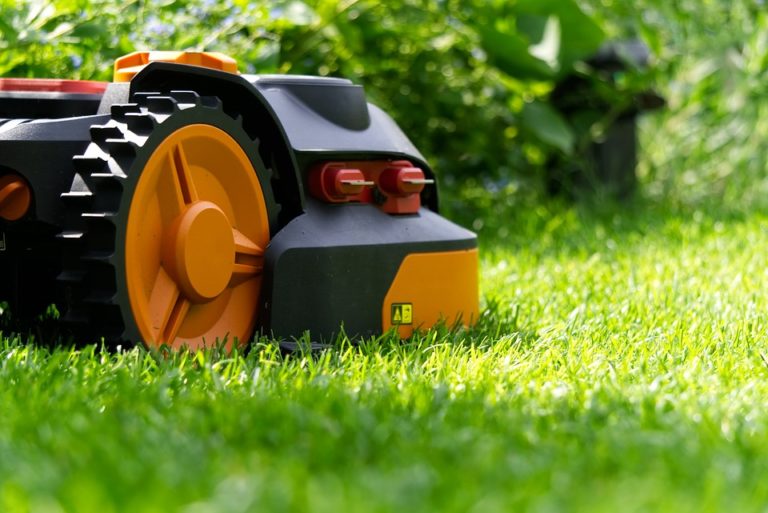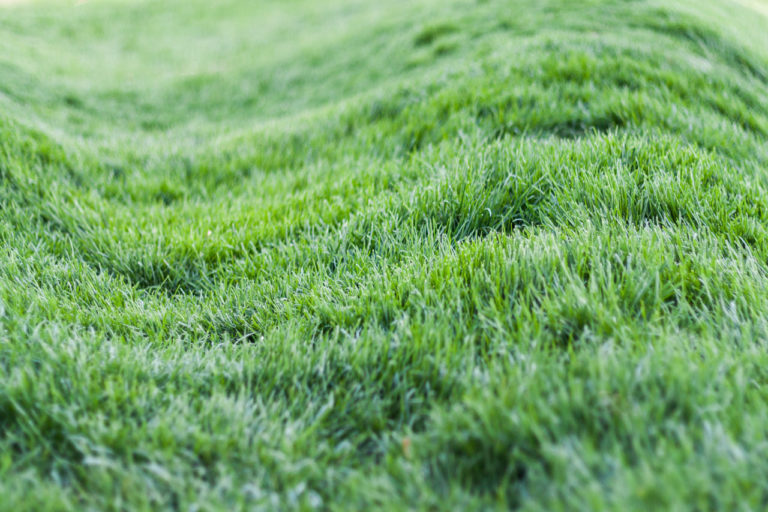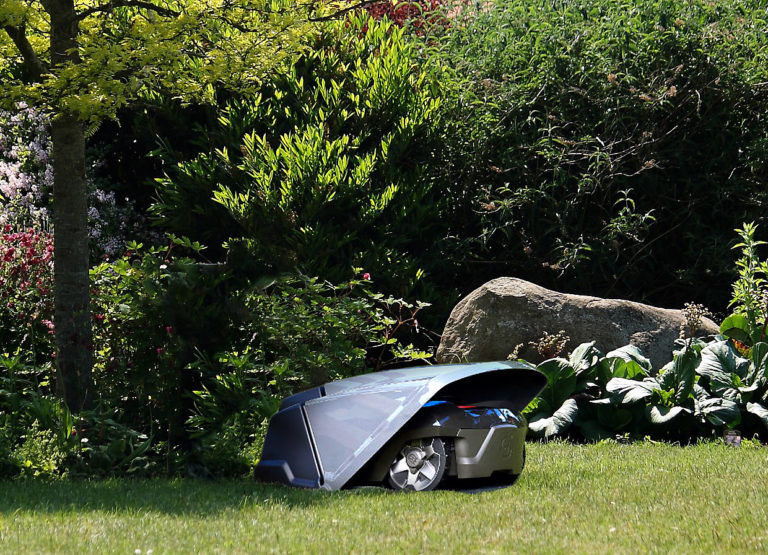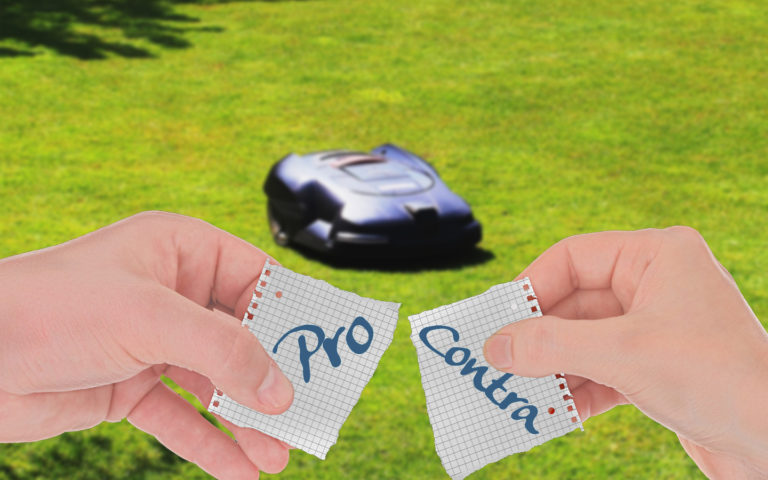Knowing how to correctly adjust the cutting height on the robotic mower can make the difference between a lawn that looks healthy and well-groomed, or a lawn that ends up ailing, yellowing and covered in weeds. The correct cutting height is probably one of the most decisive factors contributing to a healthy lawn, but many hobby gardeners do it wrong. So what is the correct cutting height and how do you set it?
How is the cutting height correctly adjusted on the mowing robot? Depending on the model, the cutting height can be adjusted mechanically with a large adjusting wheel or electronically in steps or centimeters via a display when the robot is switched off. On many lawns 4 cm is the best setting, but the cutting height depends on the type of lawn, the season, the weather conditions and other factors. It is very important to choose the correct setting, as this is one of the most important factors in lawn care.
Here you will learn how to adjust the cutting height. First off, here is a short list of cutting heights for different types of lawn and influencing factors:
- Practical lawn: 3.5 – 5 cm
- Display lawn: 2 – 3 cm
- Shaded lawn: 5 – 7 cm
- After vacation: one-third rule
- Intense heat and dryness: usual length + 1.5 cm
- During Autumn: 5 cm
- Freshly sown lawn: 5 cm
- During Winter: 2 – 3 cm
Please also see the notes in the text. Click here for the lawn cutting heights.
Contents
How is the cutting height adjusted?
Before you adjust the cutting height on the mowing robot, the robot must be switched off. On some models, you cannot reach the settings without switching it off. This is important for safety reasons.
When the robotic mower is off, you can open the cover. Depending on the model, you will find either a large adjusting wheel, which allows you to adjust the cutting height mechanically, or you will have to adjust the cutting height electronically via the display.
If you don’t find a dial – it is very large and hard to miss – you probably have a model where you can adjust the settings in the display menu. Most of the time there is a menu button that will take you there. There you can access the cutting height settings.
There are a few models where you need to adjust the cutting height by means of a set screw on the bottom of the machine, such as the Stiga models. On most lawn robots, however, you will find the settings on the top under the control panel cover.
On mowing robots with mechanical adjustment, for example, you will find an orange bar showing the current position of the adjustment. This can vary from manufacturer to manufacturer.
On devices with electronic adjustment, the current setting of the cutting height is usually very easy to see in the menu.
In this video both ways of adjusting the cutting height are presented.
What cutting heights can be set for mowing robots?
The cutting height of the mowing robots can usually be adjusted in centimetres or in steps. If you are not sure how many centimetres correspond to a step, it is best to consult the manual. Here is an example of how the steps are usually assigned. However, this may differ for your model.
- Level 1 -> 0.8 inches
- Level 2 -> 1 inches
- Level 3 -> 1.2 inches
- Level 4 -> 1.4 inches
- Level 5 -> 1.6 inches
- Level 6 -> 1.8 inches
- Level 7 -> 2 inches
- Level 8 -> 2.2 inches
- Level 9 -> 2.4 inches
Most robotic mowers offer adjustment possibilities between 0.8 inches and 2.4 inches. Some models even allow a minimum cutting height of 0.6 inches, while others also allow a maximum cutting height of 3.15 inches.
Below, we’ve listed the results of our extensive research of the cutting heights of many popular models.
- AMBROGIO L200 Carbon Blackline: 0.8 inch - 2.2 inch
- AMBROGIO L250i Elite GPS: 1 inch - 2.8 inch
- AMBROGIO L350i Elite GPS: 0.9 inch - 2.5 inch
- AMBROGIO L400: 1 inch - 3.4 inch
- AMBROGIO L60 Deluxe: 1.7 inch - 1.9 inch
- AMBROGIO L60 Elite: 1.7 inch - 1.9 inch
- AMBROGIO L85 Elite: 1 inch - 2.6 inch
- HONDA Miimo HRM310: 0.8 inch - 2.4 inch
- HONDA Miimo HRM520: 0.8 inch - 2.4 inch
- HUSQVARNA Automower 115H: 2 inch - 3.6 inch
- HUSQVARNA Automower 305: 0.8 inch - 2 inch
- HUSQVARNA Automower 310: 0.8 inch - 2.4 inch
- HUSQVARNA Automower 315: 0.8 inch - 2.4 inch
- HUSQVARNA Automower 315X: 0.8 inch - 2.4 inch
- HUSQVARNA Automower 430X: 0.8 inch - 2.4 inch
- HUSQVARNA Automower 430XH: 0.8 inch - 2.4 inch
- HUSQVARNA Automower 435X AWD: 1.2 inch - 2.8 inch
- HUSQVARNA Automower 450X: 0.8 inch - 2.4 inch
- HUSQVARNA Automower 450XH: 0.8 inch - 2.4 inch
- HUSQVARNA Automower 535 AWD: 1.2 inch - 2.8 inch
- HUSQVARNA Automower 550: 0.8 inch - 2.4 inch
- HUSQVARNA Automower 550H: 2 inch - 3.5 inch
- MCCULLOCH ROB R1000: 0.8 inch - 2 inch
- MCCULLOCH ROB S400: 0.8 inch - 2 inch
- MCCULLOCH ROB S600: 0.8 inch - 2 inch
- REDBACK POWER RM18: 0.8 inch - 2.4 inch
- REDBACK POWER RM24: 1 inch - 2.5 inch
- ROBOMOW RC306: 0.6 inch - 2.4 inch
- ROBOMOW RS612: 0.8 inch - 3.5 inch
- ROBOMOW RS622: 0.8 inch - 3.5 inch
- ROBOMOW RS630: 0.8 inch - 3.5 inch
- ROBOMOW RX20: 0.5 inch - 1.8 inch
- WORX Landroid L 20V WR150: 1.6 inch - 3.9 inch
- WORX Landroid L 20V WR153: 1.6 inch - 3.9 inch
- WORX Landroid M 20V WR140: 1.2 inch - 2.4 inch
- WORX Landroid M 20V WR143: 1.2 inch - 2.4 inch
What is the correct cutting height for the robotic mower?
Now you know how to correctly adjust the cutting height on the robotic mower and which adjustment options are available. But before you send your mower off to do its job, you must decide which setting is best for your lawn. Many people do not know that the correct height setting is crucial for the health of the lawn, or that there is more than one “correct” setting. The correct cutting height depends on the type of lawn or its use, the season, weather conditions, and other factors. In the following section, I will show you the different types of lawn and what other factors influence the optimal cutting height.
The right cutting height for every type of lawn
1. Practical lawn
The most common type of lawn is the practical lawn. Here, more robust grass varieties are used, as the lawn is subject to heavy use. It may be used for playing sports, barbecuing or even sunbathing.
The ideal cutting height here is about 1.5 inches, give or take. You can generally choose any height between 1.25 and 2 inches, but be careful to not go any shorter, as then the lawn will no longer be able to withstand the stress.
2. Display lawn
The name of this type of lawn, in which mostly the varieties red fescue and ostrich grass are used, already reveals that this is a yard which is mainly used for ornamental purposes. It is therefore under less stress, and can be mowed slightly shorter than a practical lawn. A minimum length of 0.75 inches should only be undercut in exceptional cases.
3. Shaded lawn
This can be either a normal, practical lawn that is in the shade, or a special “shade lawn” which is designed to thrive in shady places and stand up to the moss and algae that like to grow there.
Regardless of which one it is, in both cases it is recommended that the lawn should not be mowed shorter than 2 inches. This is because less sunlight reaches the lawn, grass needs a larger blade surface area to be able to absorb sufficient energy. You can even let the lawn grow up to 2.75 inches long.
Deviations from the recommended cutting height
The above-mentioned guide values for cutting heights are a good place to start. However, they may vary depending on the situation. Some examples of these are:
1. The one-third rule after vacation
When you return from a vacation where your robotic mower was not in action during your absence, but was stored inside the house, your lawn will have had enough time to become very long.
If the grass has reached a length that is 0.75 inches or more above the maximum cutting height of the robotic mower, you should first mow it with a conventional lawnmower, as it has become too long for the mowing robot. Not only does this have a negative effect on the mowing process, but it also means that too many cuttings are produced at once, which can cause the grass to begin to grow moldy.
Even if the lawn is still short enough for the robotic mower, you should observe the so-called one-third rule. This rule states that you must never cut more than 1/3 of the length of the grass, otherwise it will be too damaged and have difficulty recovering.
This means that you should not cut to the regular height after returning from a vacation during which you allowed your grass to overgrow, but gradually approach the desired length. For example, if your lawn has grown to 3.5 inches and you want a 1.5 inch high lawn, you should first mow at 2.25 inches, after which you can adjust the cutting height to 1.5 inches with a clear conscience.
2. Temperature and season influence the ideal cutting height
Depending on the temperature and season, there are some important things to consider. For example, if you are approaching several particularly dry and hot days, the cutting height should be set to about 0.5 inches higher than usual. This protects the lawn from drying out and burning. You should also water the lawn during this period. If your lawn is generally very short, you should stop mowing for a while before the heat wave hits, so that the grass has time to grow to a safe length.
Even in Autumn, it makes sense not to cut the lawn below 2 inches. This is for a similar reason as with a shaded lawn. Due to the shorter days and the flatter sunrays, the blades of grass no longer get enough light. A larger blade surface ensures that the grass is supplied with enough solar energy.
3. Cutting height for freshly seeded lawn
Freshly seeded lawns generally require special treatment. You should allow them to grow to 3.15 to 4 inches before the first mowing. After this, you can mow the grass down to 1.97 inches. However, a normal lawnmower may be necessary for this, as grass that is 3.94 inches tall is not manageable for most robotic mowers. You should also read up on special care considerations for a freshly-planted lawn.
4. Cutting height for wintering
If the cold season is approaching, you should trim the lawn to 0.75 – 1.25 inches during the last mowing before the cold hits. This will allow the lawn to winter better.
Further tips on cutting height
To recap: Too short a cut can damage your lawn and encourage weeds to migrate. But mowing too rarely also promotes weed growth. Frequent mowing is generally good, but you should not cut your lawn too short.
This formula also applies: The shorter the lawn, the more often it must be mowed to keep the lawn healthy. However, some are of the opinion that too-frequent mowing damages the lawn, as the grass will begin to grow to the side as a defense mechanism. With robotic mowers, however, it does not seem to do any real damage to the lawn if you mow daily. However, the mower should not necessarily run all day.
If your lawn has a problem with growing strongly to the side, you can straighten it out to counteract the problem. Turf grows between one and two inches per week, with temperature and rainfall being a major factor to the rate of growth. It is best to experiment with the frequency of mowing. With robotic mowers, it has proven to be best for most owners to have them mow every other day. Since they usually do not mow the entire area in one go, this is still relatively gentle on the lawn.
Is the robotic mower allowed to mow in wet conditions?
It is often not advisable to mow lawns when they are wet, as the grass will clump together, causing the mower to not mow properly. However, this does not necessarily apply to mowing robots. Whether you should mow in wet conditions or not depends on your model.
The problem of clumping does not usually arise with mowing robots, as they only ever cut off a very small fraction of the grass. In fact, mowing robots from the manufacturer Husqvarna are said to be able to cut wet lawns even slightly better than dry ones.
On the other hand, your mowing robot can get stuck in the soft moistened ground and its wheels can spin, which can damage the turf. The same applies to steep slopes in wet conditions. Some robotic mowers also get louder when they are mowing wet lawns, and become dirty faster than they do when mowing in dry conditions. This means that especially heavy robotic mowers have their problems when mowing wet lawns.
On the other hand, it is particularly important to mow the lawn regularly during rainy periods. If your lawn robot stops mowing for a longer period of time, because it doesn’t want to mow in the rain (rain sensor) the grass continues to grow uninhibited and, especially with a lot of rain, very quickly.
If your robotic mower is then used again after a long period of rain with no mowing, it must be able to cope with a fairly tall lawn. The grass clippings are then much longer because the lawn has had more time to grow since the last mowing. Unfortunately, the mulching technique does not work well with long grass clippings and can cause the clippings to mat or rot.
In any case, the prerequisite for mowing wet lawns is that the mowing blades are really sharp and that the lawn is not too long, or that the last mowing operation was not too long ago. There is also a special feature for slopes – here there is a risk that the mowing robot loses traction and its wheels spin when it is wet and on a steep gradient. This damages the turf.
What else should you consider before mowing?
In general it is important that you do not change the blades too seldom. The normal turntable blades must be changed approximately every 150 mowing hours. Some harder models made of titanium will last 220 mowing hours. With mowing robots that use a mowing cross instead of a turntable, as is the case with Robomows, you only need to change the blades once per season.
How often should you end up mowing the lawn? This depends, of course, on the equipment, the size of the lawn and the weather. However, a proven average is every one or two days, or at least three times a week. If the area output of your mowing robot is approximately the same as the size of the lawn, or even larger, this is a good guide. In the article How long does your robot mower take to mow your garden, you will find more information about how often you should mow.
Otherwise, you should observe the usual things – do not leave any objects on the lawn that could damage the robot itself, such as stones, toys, clothing or gardening tools. Thick, protruding tree roots can also be a problem, as can large piles of leaves. So make sure to remove these things from the garden before setting your robot loose.
Conclusion
Adjusting the cutting height on the mowing robot is very easy once you know how to do it. Choosing the correct cutting height can be more difficult, however, because many factors have to be taken into account. Mistakes that are made here can have a massive impact on the quality of the lawn. With the right setting, however, you will have a very healthy and happy lawn.
Related questions
How often should you change the blades on the mowing robot? Depending on the mowing system, the blades need to be changed at different intervals. If the mowing robot has a knife disc with several small, freely swinging blades, these need to be replaced approximately every 1 to 3 months. If the mowing robot uses larger star knives instead, it is sufficient to replace them once per season.
Also interesting: How often should you change the blades on the robotic mower?




